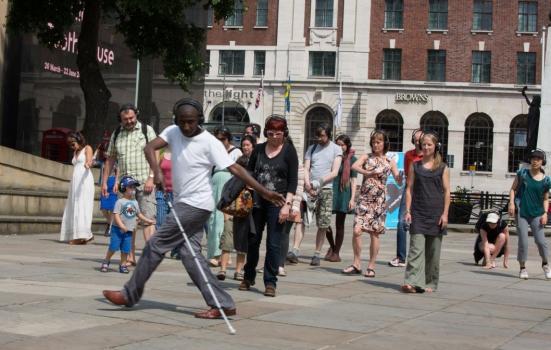An outdoor performance project featuring blind and visually impaired dancers and musicians has pulled passers-by into a world of ‘sonic vision’. Isabel Jones shares the effects on performers and audiences.

Geoffrey Fielding
Salamanda Tandem’s beginnings go far back to the mid-1980s and to Art To Share, a group of blind, visually impaired and sighted pioneers who fought for the principle of access to art through touch.
Eight blind people, including my father Lewis, performed their first dance performance to an audience of visually impaired people. Audio description, touch and live music were the means of navigation for the blind dancers, and the only sighted person present on stage was my sister who performed blindfold.
“The fact I’m using my long cane for choreography enables me to take a lead and be a dance-maker”
My father’s experience as a deafblind artist remained central over three decades, and after his death in 2012, his braille books, Perkins Brailler machines and long cane – or ‘magic stick’ as he fondly described it – were left to me and the long cane came to rest, folded on the office printer.
A world of sonic vision
That long cane was brought back to life when it was placed in the hands of a visually impaired dancer, and ‘White Cane’ was the result. Commissioned by Ludus Festival Leeds, blind, visually impaired and sighted musicians and dancers led passers-by and invited audiences into a world of sonic vision.
Performances have taken place on busy city streets, railway platforms, in parks, art gallery spaces, houses and interiors. As the long cane sweeps and rolls – exploring stone, brick, cobbles, concrete, glass, marble and grass – the tactile sensation is sonified live and transmitted through radio headphones to the audience. Live viola, sung and spoken audio description, and location recordings allow the audiences to become part of the performance and discover the space, vibration and texture for themselves.
Salamanda Tandem is built upon the idea of a sensory approach shared between blind, visually impaired and sighted artists who work across artforms. This has taken us on to the question of how an instrument for access, like the long cane, might become art.
Duncan Chapman, long-term collaborator and Co-Director of White Cane, said: “I remember right from the beginning, on my first project working with Lewis and Isabel 22 years ago, we were fascinated then by how information from one sense is transformed by the imagination into experience of another. So texture could become sound, and movement becomes the articulation of music. In White Cane it’s exciting because the hidden world of vibration and spatial sensitivity also become the material for creating an immersive experience for participants and audiences.”
Connecting people
One member of the public at Huddersfield railway station, during the Huddersfield Contemporary Music Festival, said: “You affected people who didn’t know what was going on. Takashi [the performer] waved at a train as it left the other platform, and two of the passengers on it waved back… Everybody on our train was watching and talking about what was going on.
“We explained what the performers were up to when they saw Mickel twirling on the platform opposite. Complete strangers were chatting, saying what a good idea it was, just feeling a bit more of their humanity than their regular train commuting usually allowed them.”
Mickel Smithen, the dancer in White Cane, said: “The world, and that includes the dance world, isn’t built for visually impaired people like me, but l believe in equality and disabled people ‘out there’. The fact I’m using my long cane for choreography enables me to take a lead and be a dance-maker.”
Takashi Kikuchi, the musician, said: “I haven’t seen anything through my eyes since birth, but I can feel things through my hands and feet and my white cane. I rely on these feelings and my hearing and this is what I can share in my artistic involvement. In addition to sharing these fantastic moments with people, it becomes a good opportunity to let them realise our existence and how we live… The most exciting moment is when audience members join us and do the movement with us.”
Isabel Jones is Artistic Director of Salamanda Tandem.
www.salamanda-tandem.org.uk
Tw: @salamandatandem




